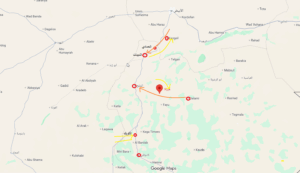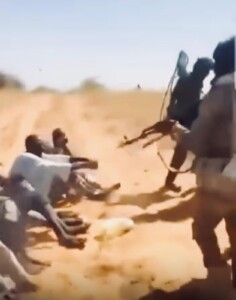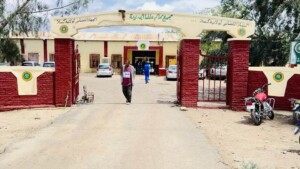Blue Nile state witnesses ‘cautious calm’ after at least 24 were killed in renewed clashes
The situation in Blue Nile state witnessed a cautious calm on Monday, the second day since the deployment of joint forces and military reinforcements from outside the region in areas where four-day-long clashes took place, which left 24 dead and at least 44 wounded.
 Victims of the renewed clashes in Um Darfa, Blue Nile state (social media)
Victims of the renewed clashes in Um Darfa, Blue Nile state (social media)
The situation in Blue Nile state witnessed a cautious calm on Monday, the second day since the deployment of joint forces and military reinforcements from outside the region in areas where four-day-long clashes took place, which left 24 dead and at least 44 wounded.
Renewed intercommunal fighting broke out last Thursday between Hausa and other ethnic groups in and around El Roseires in northern Blue Nile state.
Mohamed Mousa, representative of the Hausa in Blue Nile state, told Radio Dabanga that the number of displaced people who fled from Ganis and Um Darfa, and from neighbourhoods of the state capital Ed Damazin, has risen to more than 40,000.
“They packed their luggage and left their homes due to the absence of security and the Rule of Law and the spread of hate speech and racism,” he said.
Most of them sought refuge in Sennar, whilst others fled to El Gezira and white Nile state. Mousa said that they are living in tragic conditions due to the lack of shelter, food, and health care.
Children killed
On Sunday, Save the Children in Sudan released a statement to say that they are “deeply saddened and alarmed” by the renewed conflict and by the fact that two children were killed in the classes whilst another 10 were injured.
“We urge all parties to exert all efforts to protect civilians from violence, especially the most vulnerable families and children, and to ensure that displaced communities are not forced to return to areas where they do not feel safe,” Arshad Malik, Save the Children's country director in Sudan, said in a statement.
He also stressed that the root causes of the conflict should be addressed “in order to prevent such unrest in the future”.
Lack of resources
Listeners told Radio Dabanga on Sunday that the security situation in the region indeed witnessed a cautious calm but that more people fled their homes. They also said that Ed Damazin Teaching Hospital was unable to provide the necessary assistance to the injured due to the lack of resources.
Mawaheb Gismallah, Director of the Health Emergency Department at the Sennar state Ministry of Health said that large numbers of displaced people were re-homed in camps when they returned to their villages after the fighting in July subsided.
After a meeting with the Technical Committee for Health Emergencies in Singa, capital of Sennar, she reported a significant increase in people from Blue Nile state in the makeshift camps in El Souki and Abu Hujar. The exact number has not been counted yet but at least 90 families arrived in Sennar locality.
Land, hostility, gold rush
In mid-July, fighting erupted between Hausa and Berta and other ethnic groups in the northern part of Blue Nile state. At least 105 people were killed, and thousands of people fled to Ed Damazin and safe parts of El Roseires.
Those clashes allegedly erupted after the Hausa requested the establishment of a "civilian authority" that the other ethnic communities viewed as a means of gaining access to the land.
The El Roseires Resistance Committees however in July described the violence as a manifestation of the hostility between the two factions of the Sudan People’s Liberation Movement-North (SPLM-N) that split in 2017 following a leadership rift. The resistance committees accused the authorities of neglecting their duties because they ignored warning signs and chose not to act even after the first attacks.
Kholood Khair, leading member of a think-and-do tank in Khartoum, viewed the violence from a different angle: “This is a gold rush and a building of war chests by the emerging ethnic blocs of Burhan and the Centre vs Hemedti and the Periphery, giving a radically militarised trajectory to Sudan's political future”.
The violence in July led to the displacement of about 31,000 people, many of whom sought refuge in schools in Ed Damazin and El Roseires that have by now turned into a kind of camps for the displaced.
The clashes also sparked protests across Sudan, as the Hausa people demanded justice for the dead. Most of the demonstrations remained peaceful, but the protests in Kassala in eastern Sudan turned into bloody clashes after angry young Hausa torched government offices in the city. Two of them reportedly died.
Racism
A demonstration in Khartoum on July 19 to support Hausa in Blue Nile state, launched from the poor southern district of Mayo, was dispersed by tear gas. Activists tweeted that the demonstrators did not receive much support. “I expected more people to show up and tell them “you will never walk alone”, “we’re all Hausa” as resistance committees usually do, instead I noticed a lot of hostility and outright racism,” one of them said.
The Hausa in Sudan are part of the Hausa ethnic group, which is very influential in West Africa, politically and culturally. In the process of traveling and trading for centuries, some of them migrated east to places like Sudan – where they, as ‘black Africans’, are still seen by many as outsiders.











 and then
and then